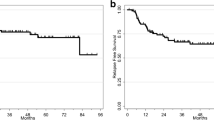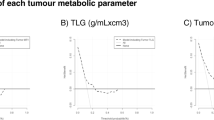Abstract
Purpose
Using integrated PET/CT, we evaluated the prognostic value of [18F]FDG uptake ratio between pelvic lymph node (LN) and primary tumor in invasive squamous cell carcinoma (SCCA) of the uterine cervix.
Methods
We retrospectively reviewed patients with International Federation of Gynecology and Obstetrics (FIGO) stages IB to IIA cervical SCCA who underwent preoperative [18F]FDG PET/CT scans. PET/CT parameters such as maximum standardized uptake value (SUV) of the primary cervical cancer (SUVcervix) and LN (SUVLN), and the LN-to-cervical cancer SUV ratio (SUVLN/SUVcervix) were assessed. Prognostic values of PET/CT-derived metabolic and volumetric variables and clinicopathology parameters were analyzed to predict progression-free survival (PFS) in regression analyses.
Results
Clinical data, treatment modalities, and results were reviewed for 103 eligible patients. Median post-surgical follow-up was 29 months (range, 6–89), and 19 (18.5%) patients experienced recurrence. Multivariate logistic regression analysis showed that SUVLN / SUVcervix > 0.1747(P = 0.048) was the independent risk factor of recurrence. Patient group categorized by SUVLN/SUVcervix showed significant difference in PFS (log-rank test, P < 0.001).
Conclusions
Preoperative SUVLN/SUVcervix measured by [18F]FDG PET/CT was significantly associated with recurrence, and has an incremental prognostic value for PFS in patients with cervical SCCA.



Similar content being viewed by others
References
Torre LA, Bray F, Siegel RL, Ferlay J, Lortet-Tieulent J, Jemal A. Global cancer statistics, 2012. CA Cancer J Clin. 2015;65(2):87–108. doi:10.3322/caac.21262.
Monk BJ, Tewari KS, Koh WJ. Multimodality therapy for locally advanced cervical carcinoma: state of the art and future directions. J Clin Oncol. 2007;25(20):2952–65. doi:10.1200/JCO.2007.10.8324.
Monk BJ, Sill MW, McMeekin DS, Cohn DE, Ramondetta LM, Boardman CH, et al. Phase III trial of four cisplatin-containing doublet combinations in stage IVB, recurrent, or persistent cervical carcinoma: a gynecologic oncology group study. J Clin Oncol. 2009;27(28):4649–55. doi:10.1200/JCO.2009.21.8909.
Moore DH, Tian C, Monk BJ, Long HJ, Omura GA, Bloss JD. Prognostic factors for response to cisplatin-based chemotherapy in advanced cervical carcinoma: a gynecologic oncology group study. Gynecol Oncol. 2010;116(1):44–9. doi:10.1016/j.ygyno.2009.09.006.
Moore DH, Blessing JA, McQuellon RP, Thaler HT, Cella D, Benda J, et al. Phase III study of cisplatin with or without paclitaxel in stage IVB, recurrent, or persistent squamous cell carcinoma of the cervix: a gynecologic oncology group study. J Clin Oncol. 2004;22(15):3113–9. doi:10.1200/JCO.2004.04.170.
Long HJ 3rd, Bundy BN, Grendys EC Jr, Benda JA, McMeekin DS, Sorosky J, et al. Randomized phase III trial of cisplatin with or without topotecan in carcinoma of the uterine cervix: a gynecologic oncology group study. J Clin Oncol. 2005;23(21):4626–33. doi:10.1200/JCO.2005.10.021.
Oncology FCoG. FIGO staging for carcinoma of the vulva, cervix, and corpus uteri. International journal of gynaecology and obstetrics: the official organ of the International Federation of Gynaecology and Obstetrics. 2014;125(2):97–8. doi:10.1016/j.ijgo.2014.02.003.
Landoni F, Maneo A, Colombo A, Placa F, Milani R, Perego P, et al. Randomised study of radical surgery versus radiotherapy for stage Ib-IIa cervical cancer. Lancet. 1997;350(9077):535–40. doi:10.1016/S0140-6736(97)02250-2.
Chung CK, Nahhas WA, Stryker JA, Curry SL, Abt AB, Mortel R. Analysis of factors contributing to treatment failures in stages IB and IIA carcinoma of the cervix. Am J Obstet Gynecol. 1980;138(5):550–6.
Boyce J, Fruchter RG, Nicastri AD, Ambiavagar PC, Reinis MS, Nelson JH Jr. Prognostic factors in stage I carcinoma of the cervix. Gynecol Oncol. 1981;12(2 Pt 1):154–65.
Delgado G, Bundy B, Zaino R, Sevin BU, Creasman WT, Major F. Prospective surgical-pathological study of disease-free interval in patients with stage IB squamous cell carcinoma of the cervix: a gynecologic oncology group study. Gynecol Oncol. 1990;38(3):352–7.
Werner-Wasik M, Schmid CH, Bornstein L, Ball HG, Smith DM, Madoc-Jones H. Prognostic factors for local and distant recurrence in stage I and II cervical carcinoma. Int J Radiat Oncol Biol Phys. 1995;32(5):1309–17. doi:10.1016/0360-3016(94)00613-P.
Horn LC, Fischer U, Raptis G, Bilek K, Hentschel B. Tumor size is of prognostic value in surgically treated FIGO stage II cervical cancer. Gynecol Oncol. 2007;107(2):310–5. doi:10.1016/j.ygyno.2007.06.026.
Waggoner SE. Cervical cancer. Lancet. 2003;361(9376):2217–25. doi:10.1016/S0140-6736(03)13778-6.
Signorelli M, Guerra L, Montanelli L, Crivellaro C, Buda A, Dell’Anna T, et al. Preoperative staging of cervical cancer: is 18-FDG-PET/CT really effective in patients with early stage disease? Gynecol Oncol. 2011;123(2):236–40. doi:10.1016/j.ygyno.2011.07.096.
Bentivegna E, Uzan C, Gouy S, Leboulleux S, Duvillard P, Lumbroso J, et al. Correlation between [18f]fluorodeoxyglucose positron-emission tomography scan and histology of pelvic nodes in early-stage cervical cancer. Anticancer Res. 2010;30(3):1029–32.
Choi HJ, Ju W, Myung SK, Kim Y. Diagnostic performance of computer tomography, magnetic resonance imaging, and positron emission tomography or positron emission tomography/computer tomography for detection of metastatic lymph nodes in patients with cervical cancer: meta-analysis. Cancer Sci. 2010;101(6):1471–9. doi:10.1111/j.1349-7006.2010.01532.x.
Chung HH, Cheon GJ, Kang KW, Kim JW, Park NH, Song YS. Preoperative PET/CT FDG standardized uptake value of pelvic lymph nodes as a significant prognostic factor in patients with uterine cervical cancer. Eur J Nucl Med Mol Imaging. 2014;41(4):674–81. doi:10.1007/s00259-013-2626-1.
Pecorelli S. Revised FIGO staging for carcinoma of the vulva, cervix, and endometrium. International journal of gynaecology and obstetrics: the official organ of the International Federation of Gynaecology and Obstetrics. 2009;105(2):103–4.
Budiawan H, Cheon GJ, Im HJ, Lee SJ, Paeng JC, Kang KW, et al. Heterogeneity analysis of (18)F-FDG uptake in differentiating between metastatic and inflammatory lymph nodes in adenocarcinoma of the lung: comparison with other parameters and its application in a clinical setting. Nucl Med Mol Imaging. 2013;47(4):232–41. doi:10.1007/s13139-013-0216-6.
Bradburn MJ, Clark TG, Love SB, Altman DG. Survival analysis part II: multivariate data analysis--an introduction to concepts and methods. Br J Cancer. 2003;89(3):431–6. doi:10.1038/sj.bjc.6601119.
Bland JM, Altman DG. The logrank test. BMJ. 2004;328(7447):1073. doi:10.1136/bmj.328.7447.1073.
Altman DG, Gore SM, Gardner MJ, Pocock SJ. Statistical guidelines for contributors to medical journals. Br Med J. 1983;286(6376):1489–93.
Nikolic D, Muresan RC, Feng W, Singer W. Scaled correlation analysis: a better way to compute a cross-correlogram. Eur J Neurosci. 2012;35(5):742–62. doi:10.1111/j.1460-9568.2011.07987.x.
Grigsby PW, Siegel BA, Dehdashti F. Lymph node staging by positron emission tomography in patients with carcinoma of the cervix. J Clin Oncol. 2001;19(17):3745–9. doi:10.1200/jco.2001.19.17.3745.
Yen TC, See LC, Lai CH, Tsai CS, Chao A, Hsueh S, et al. Standardized uptake value in para-aortic lymph nodes is a significant prognostic factor in patients with primary advanced squamous cervical cancer. Eur J Nucl Med Mol Imaging. 2008;35(3):493–501. doi:10.1007/s00259-007-0612-1.
Kidd EA, Siegel BA, Dehdashti F, Grigsby PW. Pelvic lymph node F-18 fluorodeoxyglucose uptake as a prognostic biomarker in newly diagnosed patients with locally advanced cervical cancer. Cancer. 2010;116(6):1469–75. doi:10.1002/cncr.24972.
Vergote I, Tsolakidis D, Mortier D, Neven P, Amant F, Mottaghy F, et al. Value of positron emission tomography of the para-aortic lymph nodes in cervical carcinoma stage IB2-IIIB. J Clin Oncol. 2008;26(34):5654–5655; author reply 5-7. doi:10.1200/JCO.2008.19.5883.
Yildirim Y, Sehirali S, Avci ME, Yilmaz C, Ertopcu K, Tinar S, et al. Integrated PET/CT for the evaluation of para-aortic nodal metastasis in locally advanced cervical cancer patients with negative conventional CT findings. Gynecol Oncol. 2008;108(1):154–9. doi:10.1016/j.ygyno.2007.09.011.
Author information
Authors and Affiliations
Corresponding author
Ethics declarations
Funding
None.
Conflicts of interest
The authors declare that they have no conflicts of interest.
Ethical approval
All procedures performed in studies involving human participants were in accordance with the ethical standards of the institutional and/or national research committee and with the 1964 Helsinki declaration and its later amendments or comparable ethical standards. For this type of retrospective study, formal consent is not required.
Rights and permissions
About this article
Cite this article
Chung, H.H., Cheon, G.J., Kim, JW. et al. Prognostic importance of lymph node-to-primary tumor standardized uptake value ratio in invasive squamous cell carcinoma of uterine cervix. Eur J Nucl Med Mol Imaging 44, 1862–1869 (2017). https://doi.org/10.1007/s00259-017-3729-x
Received:
Accepted:
Published:
Issue Date:
DOI: https://doi.org/10.1007/s00259-017-3729-x




